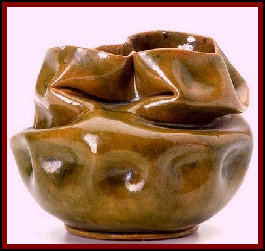














NOVA-Antiques was mentioned by Jura Koncius of the
NOVA-Antiques was selected Website of the Week by Evan Haning and WTOP Radio in
NOVA-Antiques
was designated a resource for antiques flea markets in an article in the Weekend Section of the

Thank you for your continued support and readership. Please insure to forward this Newsletter to your friends and neighbors. If you no longer wish to receive our emails regarding the update of this page, please send us an email to info@nova-antiques.com with the subject line "OPT OUT"
NOVA-Antiques.com does not run, manage or operate any of the flea markets, auction houses or estate sale companies advertised on this page. The NOVA-Antiques Newsletter is published for the exclusive use, enjoyment and convenience of our readers and subscribers. Any questions regarding the flea markets, auction houses and estate sale companies should be directed to the appropriate owner, promoter or manager.
American Pottery Artist – George E. Ohr
George E. Ohr, whose family was originally from France, was born in 1857 in Mississippi
and is well known for his work with modern clay forms and for the amount of work that he produced. Reportedly he produced more
than 10,000 pieces and claimed that no two were exactly alike. Although many collectors now consider him a genius, in the late
eighteen hundreds and early nineteen hundreds, other craftsmen did not accept him because of abstract expressionistic pottery or because
he boasted and was considered a loudmouth.
Today, his work is renowned and collectors clamor for his work. Some of the things that set his work apart from others are the
glazes that he used and the forms or shapes that he was able to accomplish using a potter’s wheel. Many have tried to
replicate his designs using the wheel and have failed. George E. Ohr marked most of his works and is easily identifiable. Additionally, his works are widely exhibited throughout the United States and Europe and a large collection of his works are displayed
in the Ohr-O’Keefe Museum in Biloxi, Mississippi. A lot of collectors or would be collectors turn to OldPottery.com a great
site that has information on how to identify George E. Ohr pottery.
Like other antiques and vintage collectibles, the value of antique pottery depends on many factors,
but the most important thing is “what is someone willing to pay for it?” Aside from that, there are some other things that collectors
will look for when purchasing pottery for their collections including its condition, collectability and of course can it be attributed
to one of the great potters.
Antique pottery is probably one of the easier antique and vintage collectible items to identify because we find that most potters
marked their wares. Normally, the potter will have marked their creation under the glaze on the bottom of a bowl, platter or
vase. The marks can be very revealing, telling us not only who the potter was, but when a particular piece may have been made
and a lot of times even the country of origin. These marks can be very important when trying to determine what something is
worth.
Aside from the potters mark, the other things that may increase or decrease the value of a piece of pottery is its condition. Many antique and vintage pottery collectors will only pay for pieces that have no cracks, although some will make an exception for
rare pieces that contain hairline cracks that do not come through the piece. Other things that collectors shy away from are
chips and nicks, especially around the outside rims of vases or bowls. Again, some exceptions are made if the pottery is rare
and can be displayed in a cabinet with its flaws hidden. In either case, no matter the potters mark, a collector will not pay
top dollar for flawed pieces.

Apart from rarity, another thing that collectors look for are pottery that are hand painted as opposed to mass produced pottery that
has printed or stamped designs. Because of this, pottery from the late eighteen hundreds tends to be the most popular to collect;
most potters from that era are well known for their original, artistic and naturalistic designs. Potters from this time period
include Charles Volmar, George Ohr, Grueby Faience and of course Artus Van Briggle; many other great potters worked for manufacturers
like Rookwood and Weller. Most pieces of pottery from this era tend to be rare and one of a kind.